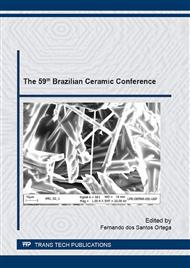p.3
p.7
p.12
p.18
p.24
p.30
p.35
p.41
Effect of Iron and Vanadium on the Phase Transition of Titanium Dioxide Obtained by Polymeric Precursor Method
Abstract:
The titanium dioxide phase formation is dependent on the synthesis method, temperature of calcination and modifiers insertion. By using chemical methods, such as Polymeric Precursor Method, the organic impurities or extrinsic defects caused by doping play an important rule on the formation of precursor structure before the phase crystallization above 500 oC. Some dopants can change the decomposition mechanism of the precursor, which affects the anatase-rutile phase transition. In this work, the Polymeric Precursor Method was used to synthesize titanium dioxide powder samples in order to investigate the effects of iron (III) and vanadium (V) dopants on the phase formation. Through thermal analysis of polymeric precursors and X-ray diffractometry for calcined powder samples it was possible to show the existence of antagonistic effects for both investigated dopants. While the iron doping reduces the anatase phase tetragonality and delays the rutile phase conversion, the vanadium one changes the mechanism of decomposition of polymeric precursor and leads to more amount of rutile phase.
Info:
Periodical:
Pages:
18-23
Citation:
Online since:
November 2016
Keywords:
Price:
Сopyright:
© 2017 Trans Tech Publications Ltd. All Rights Reserved
Share:
Citation:


